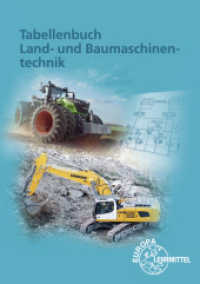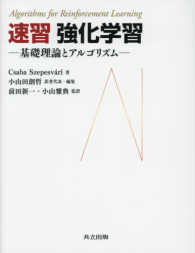- ホーム
- > 洋書
- > 英文書
- > Business / Economics
Full Description
Are the recurring recessions of the capitalist world merely short-term adjustments to changing economic circumstances in a system that tends, in general, toward equilibrium? In this accessible study of the business cycle, Howard Sherman makes a powerful case that recessions and painful involuntary unemployment are endogenous to capitalism. Drawing especially on the work of Wesley Clair Mitchell, Karl Marx, and John M. Keynes, Sherman explains why the nature of the business cycle produces serious economic loss and misery during its contraction phase, just as it produces growth in its expansion phase. Originally published in 1991. The Princeton Legacy Library uses the latest print-on-demand technology to again make available previously out-of-print books from the distinguished backlist of Princeton University Press. These editions preserve the original texts of these important books while presenting them in durable paperback and hardcover editions. The goal of the Princeton Legacy Library is to vastly increase access to the rich scholarly heritage found in the thousands of books published by Princeton University Press since its founding in 1905.
Contents
*FrontMatter, pg. i*Contents, pg. vii*List of Figures, pg. xv*List of Tables, pg. xix*Preface, pg. xxi*CHAPTER 1. The Waste of the Business Cycle, pg. 3*CHAPTER 2. Measuring the Business Cycle, pg. 7*CHAPTER 3. History of the Business Cycle, pg. 23*CHAPTER 4. Endogenous and Exogenous Cycle Theories, pg. 50*CHAPTER 5. Consumption, pg. 83*CHAPTER 6. Investment: The Profit Hypothesis, pg. 110*CHAPTER 7. The Multiplier-Accelerator Model, pg. 138*CHAPTER 8. Income Distribution: The Utilization-Unemployment Hypothesis, pg. 157*CHAPTER 9. Demand-Side Theories: The Underconsumption Hypothesis, pg. 191*CHAPTER 10. Cost of Plant, Equipment, and Raw Materials, pg. 208*CHAPTER 11. Overinvestment and Reserve Army Theories of the Business Cycle: A Walk on the Supply Side, pg. 215*CHAPTER 12. Profits and Profit Rates, pg. 232*CHAPTER 13. Profit Squeeze (or Nutcracker) Theory of the Cycle: A Production-Realization Hypothesis, pg. 248*CHAPTER 14. Credit and Financial Crises, pg. 269*CHAPTER 15. Monopoly Power and Business Cycles, pg. 295*CHAPTER 16. The International Economy and Business Cycles, pg. 317*CHAPTER 17. Government Fiscal Behavior and the Business Cycle, pg. 339*CHAPTER 18. Can Reform Policies Lessen the Business Cycle under Capitalism?, pg. 363*CHAPTER 19. Can the Business Cycle Be Eliminated?, pg. 386*Appendixes, pg. 393*References, pg. 417*Index, pg. 433








